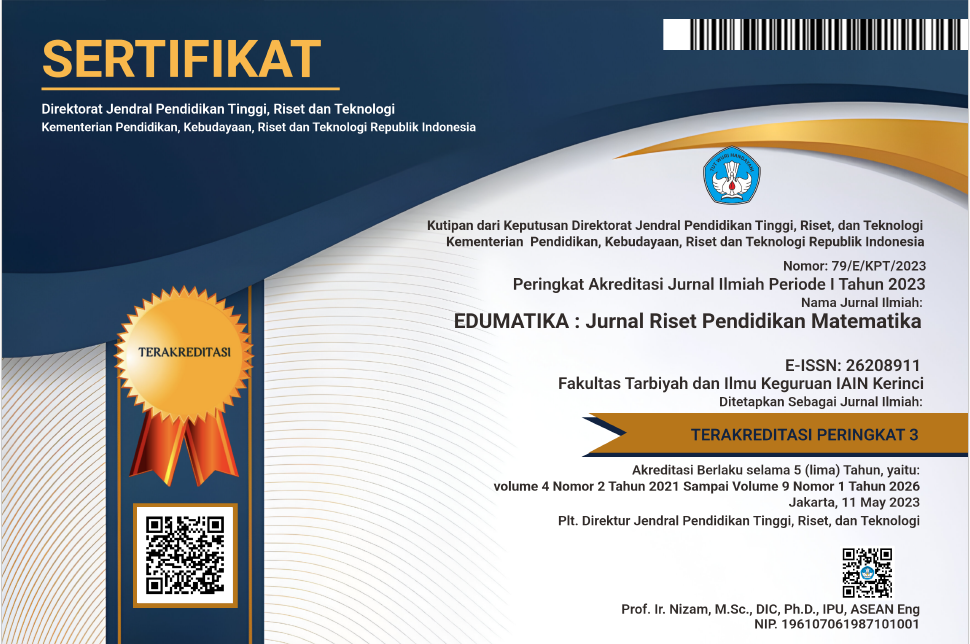A Comparative Analysis of Non-Routine Problems in Mathematics Textbooks of Indonesia and Singapore
Abstract
Textbooks used in schools affect the quality of mathematics learning in the country. Indonesian Ministry of Education (Kemendikbud) already lauched students’ and teachers’ textbook that are distributed nationally on 2013; however improvements are needed to revise the textbooks since there are concerns such as the difficulty level of problems contained in the textbooks. The main objective of this study is to compare non-routine problems contained in mathematics textbooks used in Indonesia and Singapore. This is a qualitative research with content analysis design. Researchers compare Singaporean and Indonesian mathematics textbook since Singapore got higher rank in mathematics based on PISA result in 2018. The topic in this study is limited to Pythagorean Theorem. The result of the research shows that Indonesia and Singapore has consecutively 22,1% and 11,3% non-routine problem. Another finding of this study was Singaporean mathematics textbook focused more on developing students’ fluency of solving problems, meanwhile Indonesian mathematics textbook focused more on students’ reasoning ability. The results and findings in this paper are expected to provide input in developing future mathematics textbooks.
Downloads
References
Arslan, C., & Altun, M. (2007). Learning To Solve Non-routine Mathematical Problems. Elementary Education Online, 6(1), 50–61.
As’ari, A. R., Tohir, M., Valentino, E., Imron, Z., & Taufiq, I. (2017). Matematika Kelas VIII SMP/MTs Semester 2. Kementerian Pendidikan dan Kebudayaan.
Bengtsson, M. (2016). How to plan and perform a qualitative study using content analysis. NursingPlus Open, 2, 8–14. https://doi.org/10.1016/j.npls.2016.01.001
Fajriatin, A. (2015). Analisis Buku Siswa Matematika Kurikulum 2013 Kelas IX Bab Sistem Persamaan Linear Dua Variabel Berdasarkan Konten pada Kriteria Bell. Proceedings of Seminar Nasional Matematika Dan Pendidikan Matematika UNY 2015, 71–76.
Fraenkel, J. R., Wallen, N. E., & Hyun, H. H. (2011). How to Design and Evaluate Research in Education. McGraw-Hill.
Goldin, G. A. (2010). Problem Solving Heuristics, Affect, and DiscreteMathematics: A Representational Discussion. In B. Sriraman & L. English (Eds.), Theories of Mathematics Education (pp. 241–250). Springer International Publishing.
Lisarani, V., Parta, I., & Chandra, T. (2019). A Comparative Analysis of the Tasks from the Selected Mathematics Textbooks of Singapore and Indonesia. Jurnal Pendidikan Sains, 6(4), 94–99.
Muklis, Y. M., & Setyaningsih, N. (2015). Analisis Buku Siswa Kurikulum 2013 Kelas VII SMP Pelajaran Matematika Ditinjau dari Implementasi Pendekatan Scientific dan Penilaian Autentik. Seminar Nasional Matematika Dan Pendidikan Matematika 2015, 372–384. https://publikasiilmiah.ums.ac.id/bitstream/handle/11617/5965/372_384 YOGA MUHAMMAD.pdf?sequence=1&isAllowed=y
OECD. (2013). 2012 Released Mathematics Items. PISA, OECD Publishing.
OECD. (2016). PISA 2015 Results (Volume I): Excellence and Equity in Education. PISA, OECD Publishing.
OECD. (2018). What 15-year-old Students in Indonesia Know and Can do. In Programme for International Student Assessment (PISA) Result from PISA 2018 (pp. 1–10).
OECD. (2019). PISA 2018 Results. Combined Executive Summaries (Vol. 53, Issue 9). www.oecd.org/about/publishing/corrigenda.htm.
özer, E., & Sezer, R. (2014). A Comparative Analysis of Questions in American, Singaporean, and Turkish Mathematics Textbooks Based on the Topics Covered in 8th Grade in Turkey. Educational Sciences: Theory & Practice, 14(1), 411–421. https://doi.org/10.12738/estp.2014.1.1688
Putri, A. (2018). Analisis Kemampuan Pemecahan Masalah Rutin dan Non-rutin pada Materi Aturan Pencacahan. Jurnal Pendidikan Tambusai, 2(4), 1–13.
Retnawati, H. (2015). Hambatan Guru Matematika Sekolah Menengah Pertama dalam Menerapkan Kurikulum Baru. Cakrawala Pendidikan, 24(3).
Seguin, R. (1989). The Elaboration of School Textbooks: Methodological guide. In Unesco.
Sutherland, R. (2007). Teaching for Learning Mathematics. Bell & Bain, Ltd.
Widyaharti, M. S., Trapsilasiwi, D., & Fatahillah, A. (2015). Analisis Buku Siswa Matematika Kurikulum 2013 untuk Kelas X Berdasarkan Rumusan Kurikulum 2013. Kadikma, 6(2), 173–184.
Woodward, J., SoUnd, S., Georgia, M., Franke, M., Herzig, P., Jitendra, A., Koedinger, K. R., & Ogbuehi, P. (2012). Improving mathematical problem solving in grades 4 through 8: A practice guide (NCEE 2012-4055). In National Center for Education Evaluation and Regional Assistance, Institute of Education Sciences, U.S. Department of Education. papers3://publication/uuid/FEC855E4-BFA6-4FC0-9784-3A6860CD4EAE
Yang, D. C. (2014). The Study of Geometric Contents in the Middle Grade Mathematics Textbooks in Singapore, Taiwan, and U.S.A. Proceedings of the International Conference on Mathematics Textbook Research and Development, 501–504.
Yeo, J., Seng, T. K., Yee, L. C., Chow, I., Hong, O. C., & Liew, J. (2015). New Syllabus Mathematics Textbook. Shinglee Publishers PTE LTD.
Copyright (c) 2021 author(s) and is published under license from the author(s)

This work is licensed under a Creative Commons Attribution 4.0 International License.















